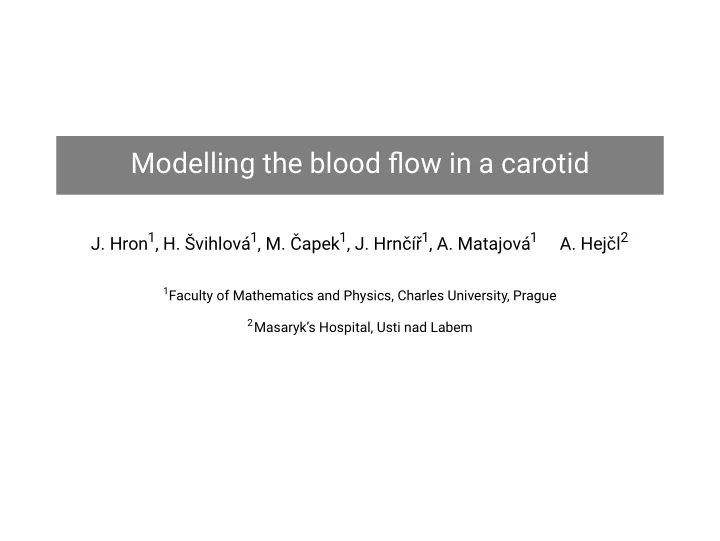

Modelling the blood flow in a carotid J. Hron 1 , H. Švihlová 1 , M. Čapek 1 , J. Hrnčíř 1 , A. Matajová 1 A. Hejčl 2 1 Faculty of Mathematics and Physics, Charles University, Prague 2 Masaryk’s Hospital, Usti nad Labem
Carotid stenosis ☞ Carotid artery disease ■ Plaque deposits can grow larger and larger, severely narrowing the artery and reducing blood flow to the brain. ■ Plaque deposits can roughen and deform the artery wall, causing blood clots to form and blocking blood flow to the brain. https://mayfieldclinic.com/pe- ☞ blood flow - mostly laminar, incompressible, isothermal, viscoelastic behaviour, mechanical interaction with surroundings - FSI, chemical reactions, clot formation....
Navier-Stokes solver ■ FEM discretization P 2 /P 1 or MINI element (FEniCS) ■ solvers PETSc - parallel composable solvers ■ coupled direct solution - MUMPS, projection methods IPCS, preconditioned iterative solvers GMRES + PCD (FENaPack https://github.com/blechta/fenapack ) or LSC (PETSc) strong and weak
Carotid stenosis ■ given CT/MRI segmentation, mesh the domain (VMTK), compute flow ■ outflow boundary conditions? (outflow mean pressure, flux by Murry’s Law) 1000 900 800 peak velocity [mm/s] 700 600 500 400 300 200 0.0 0.5 1.0 1.5 2.0 2.5 3.0 time [s] ANIMATION - not included
Carotid stenosis Look for correlation between histology and CFD results Wiedermann ACI dx C 3 mm nad bifurkací B A V místě bifurkace 20 mm pod bifurkací
Blood properties ■ Where is the non-Newtonian model really needed? ■ There are some models available... Shear−Thinning µ 0 Viscosity Newtonian µ µ 8 II. I. III. Shear Rate Anand M, Rajagopal K (2017) A Short Review of Advances in the Modelling of Blood Rheology and Clot Formation.
Microstructure based model Owens RG (2006) A new microstructure-based constitutive model for human blood Moyers-Gonzalez MA, Owens RG (2008) A non-homogeneous constitutive model for human blood. Simplifying assumptions: ■ Newtonian solvent ■ basic (micro)structure - dumbbell Specific assumptions: ■ dilute solution - dumbbells do interact, aggregation at rate . . γ ),disaggregation at rate b( γ ) a( ■ N k - the number density of k-aggregates ■ N 0 := P ✶ k=1 kN k number density of red blood cells ■ M := P ✶ k=1 N k number density of rouleaux
Microstructure based model - Owens ■ stochastic differential equations for elements of q -the end to end vector of a dumbbell. s d q dt = r u ✁ q – 2H 4k B T ✏ q – d W (t), ✏ where ✏ is so-called friction coefficient, W (t) is a multidimensional Wiener process, H is a spring constant, k B is Boltzmann constant, T the temperature. ■ ✮ Fokker-Planck ✮ with ✥ ( q , t) the probability density function. ■ Kramers expression for the extra-stress tensor T = T S + τ = 2 ✑ S D + nH < qq > –nk B T I , where n = N 0 M is the average dumbbells/aggregates size
Microstructure based model - Owens Complete system for unknowns ( v , p, τ , σ , N 0 , M): ✪❅ v ❅ t + div ( ✪ v ✡ v ) = div( T + τ ) + ✪ f div v = 0 r . τ + ¯ ✖ τ –D tr ¯ ✖ ( ∆ τ + ( rr : τ ) I ) = N 0 (k B T + ✔ ) ¯ ✖ γ r . σ + ¯ ✖ σ –D tr ¯ ✖ ( ∆ σ + ( rr : σ ) I ) = M(k B T + ✔ ) ¯ ✖ γ DN 0 D tr Dt – D tr ∆ N 0 = (k B T + ✔ ) rr : τ . . DM (k B T + ✔ ) rr : σ – a( D tr 2 M 2 + b( γ ) γ ) Dt – D tr ∆ M = 2 (N 0 – M)
Microstructure based model - Owens ■ it captures non-homogeneity of red blood cell distribution, i.e. it results into non-constant hematocrit across vessel ■ it can capture for example Fahraeus effect ■ implemented by M. Čapek using deal.II ( https://www.dealii.org/ )
Microstructure based model - Owens Recent results of some computations: agregates density RBC density
Recommend
More recommend